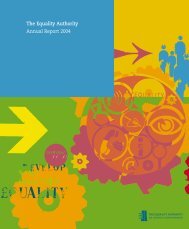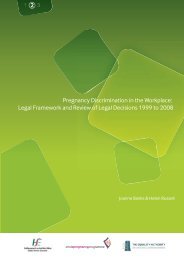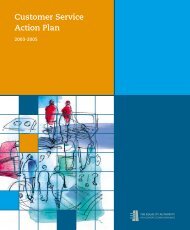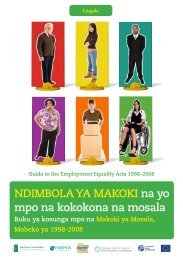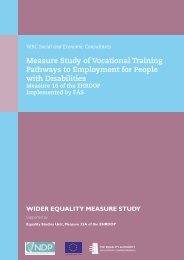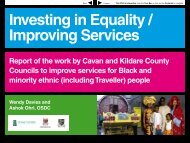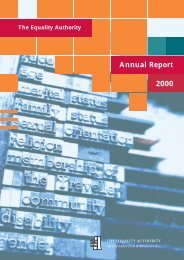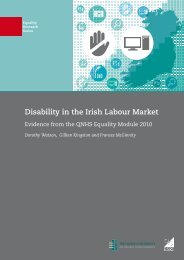Pregnancy and Employment: A Literature Review - Crisis Pregnancy ...
Pregnancy and Employment: A Literature Review - Crisis Pregnancy ...
Pregnancy and Employment: A Literature Review - Crisis Pregnancy ...
You also want an ePaper? Increase the reach of your titles
YUMPU automatically turns print PDFs into web optimized ePapers that Google loves.
<strong>Pregnancy</strong> <strong>and</strong> <strong>Employment</strong>: A <strong>Literature</strong> <strong>Review</strong><br />
Most of the studies of the occupational effects of taking time out of the labour market to care for children are<br />
limited to the first job after return. Therefore, rather little is known about the sustainability of these jobs <strong>and</strong><br />
whether, on their return to work, women manage to regain any of the losses experienced. However there are a<br />
number of significant exceptions, including the Macran et al study of British women (1996). They found that the<br />
length of the gap had little effect on the possibility of leaving the job within one year but after one year those who<br />
returned to work sooner were more likely to stay in work longer. Studies of the motherhood pay penalty (outlined<br />
below) suggest that the negative effects of time out of the labour market on pay are persistent <strong>and</strong> long-term.<br />
The cross-national study by Russell et al (2006) (described in Chapter 3) examined the medium-term effects of<br />
time spent out of the labour market around childbirth in Irel<strong>and</strong>, Germany, Sweden <strong>and</strong> the UK, using national<br />
longitudinal data-sets. By looking at these effects five years <strong>and</strong> seven years after the birth, it examines whether<br />
disadvantages persist over time, while the comparative element of the study highlights possible institutional<br />
influences on the persistence of inequalities.<br />
The results show that, after five years, women in Britain <strong>and</strong> Irel<strong>and</strong> who had a birth in the first year of the panel<br />
had significantly lower occupational scores than women with similar characteristics who did not have a birth. A<br />
significant difference between those who had <strong>and</strong> had not given birth was observable seven years later in Britain<br />
<strong>and</strong> Sweden. This effect is in addition to the negative effect of having other children aged under 16 at year 0,<br />
which is significant in Irel<strong>and</strong>, Britain <strong>and</strong> Germany. These negative effects are also additional to the decline in<br />
status associated with reduced labour-market experience. It is argued that the absence of this effect for mothers<br />
in Germany supports the hypothesis that extended periods of leave help to preserve the occupational position of<br />
those who re-enter employment. However, the negative effect of having a birth on women’s occupational status<br />
found in Sweden, seven years after the birth, suggests that extensive maternity protection in that country did not<br />
protect mothers from this disadvantage. The study found no medium-term effects of births on women’s wages five<br />
years after the birth, but the length of time in the labour market between the first <strong>and</strong> fifth interviews was found to<br />
be significant (Russell et al, 2006).<br />
These cross-national comparisons provide some support for the view that providing maternity <strong>and</strong> parental leave<br />
reduces occupational downgrading by guaranteeing employment at the same level <strong>and</strong> by increasing job tenure.<br />
Occupational downgrading <strong>and</strong> part-time work<br />
The studies outlined above highlight that a significant proportion of women reduce their hours or work parttime<br />
following childbirth. It has recently been argued that the move into part-time work is one of the primary<br />
mechanisms behind occupational downgrading among women in Britain (Connolly & Gregory, 2008). Using<br />
data from the New Earnings Panel Survey (NESPD) <strong>and</strong> the British Household Panel Survey (BHPS) 36 , Connolly &<br />
Gregory examined all transitions from full-time to part time work in consecutive years among women aged 22 to<br />
59 years of age between 1991 <strong>and</strong> 2001. The restriction of the analysis to transitions in consecutive years means<br />
that women who move to part-time work following a break of longer than one year are not included. 37 The 15-point<br />
occupational ranking used in the study is based on the average qualification level of incumbents calculated from<br />
the Labour Force Survey. This leads to some differences from st<strong>and</strong>ard occupational <strong>and</strong> class hierarchies, most<br />
notably by having teachers at the top of the hierarchy, <strong>and</strong> the placement of corporate managers below Nurses<br />
<strong>and</strong> other associate professionals.<br />
The authors found that in their two samples, 8% (NESPD) <strong>and</strong> 17% (BHPS) of women who switched into parttime<br />
work were downwardly mobile. However, this figure was considerably higher for those who also changed<br />
employer-“movers”-33% (NESPD) <strong>and</strong> 41% (BHPS) than among those who changed to part-time hours with the<br />
same employer-“stayers”-(between 6% <strong>and</strong> 17%). Since these women have worked continuously or taken a break<br />
of only one year the authors argue that this “is the rosier part of the picture” (ibid. F73). Multinomial regression<br />
analysis confirmed that controlling for other relevant factors, there is a high risk of downward mobility for movers,<br />
while transitions to part-time work that did not involve a change of employer were associated with a much smaller<br />
(though still statistically significant) risk of downgrading.<br />
36 The NESPD has a very big sample size (over 70,000 women per year), while the BHPS has a smaller sample (N women approx 2500 per year)<br />
but a much richer set of variables.<br />
37 The BHPS records Maternity leave <strong>and</strong> this is treated as continuous employment, while in the NESPD gaps of a single year are treated as<br />
consecutive.<br />
PAGE 41




